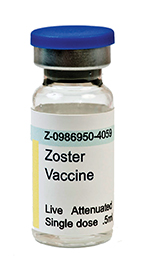Medicare & Shingles Vaccine
Posted on March 29, 2016 by bob in Medicare
Anyone who has suffered from shingles knows the pain is excruciating. “Uncomfortable” doesn’t begin to describe your plight if you come down with the disease. “Miserable” is much closer to the truth.
Shingles produces a blistering skin rash that lasts from two to four weeks. It usually  appears on just one side of your body, most often on the torso or face. You also may have a fever, headache, chills or an upset stomach. When the blisters finally go away, you may be left with scars. And for one in every five sufferers, the pain continues – sometimes for a year or more.
appears on just one side of your body, most often on the torso or face. You also may have a fever, headache, chills or an upset stomach. When the blisters finally go away, you may be left with scars. And for one in every five sufferers, the pain continues – sometimes for a year or more.
You can’t catch shingles from someone else. The disease — also known as herpes zoster — is caused by the same virus that causes chickenpox. The virus actually starts as chickenpox, the childhood illness that comes with a fever, sore throat and rash. When the chickenpox ends, however, the virus doesn’t.
It hides in your nerves and, for some people, emerges later as shingles. No one knows why that happens, but shingles is more common after age 60 and among people whose immune systems have been weakened by a disease like cancer.
About 1 million Americans a year get shingles. Most will have only one outbreak in life, though a second or third outbreak can occur. Fortunately, you can prevent shingles or at least blunt its effect with a vaccine. The U.S. Centers for Disease Control and Prevention recommends a one-time shot if you’re 60 or older.
The vaccine reduces the risk of shingles by about 50 percent. If you do come down with it, you’re likely to have a milder case if you’ve been inoculated. There have been no serious problems with the vaccine, though the CDC cautions that anyone with a weakened immune system should not be inoculated.
The most common side effects have been redness, soreness, swelling or itching at the shot site. If you have any questions, visit with your doctor. Medicare covers the shingles vaccine as one of its preventive benefits. But, unlike some other vaccines that are paid through Part B, the shingles vaccine is covered by Part D.
That’s the part of Medicare you use when you buy prescription drugs at your pharmacy.
People get Part D through a private stand-alone drug plan, if they have traditional Medicare, or through a Medicare Advantage plan that includes drug coverage.
Your Part D plan will pay for the vaccine itself and for your doctor or other health care provider to give you the shot. But you need to make sure you follow your particular plan’s rules in order to keep your out-of-pocket cost as low as possible.
The average copayment for Medicare beneficiaries who get inoculated for shingles is $60 to $80, though that will vary by plan.
If you’re vaccinated at a drugstore, check to make certain it’s in your Part D plan’s pharmacy network. Otherwise, the shot will cost you more than your usual copay.
If you’re inoculated in a doctor’s office, check to make sure the office can bill your plan or at least can work through a drugstore in your plan’s network. Otherwise, you’ll have to pay the entire bill upfront and then claim reimbursement from your plan.
Just to be safe, call your Part D drug plan ahead of time and ask which pharmacies and doctors in your area you can use to receive the shingles vaccine at the plan’s regular copay.
To learn more about shingles, contact the Centers for Disease Control and Prevention at 1-800-232-4636 or visit www.cdc.gov/vaccines. For more about Medicare’s coverage, call 1-800-MEDICARE or go to www.medicare.gov.
As today’s 78 million baby boomers age, the number of shingles cases will only increase. Guard yourself against the pain and suffering. Get vaccinated.
Bob Moos is Southwest public affairs officer for the U.S. Centers for Medicare & Medicaid Services.









